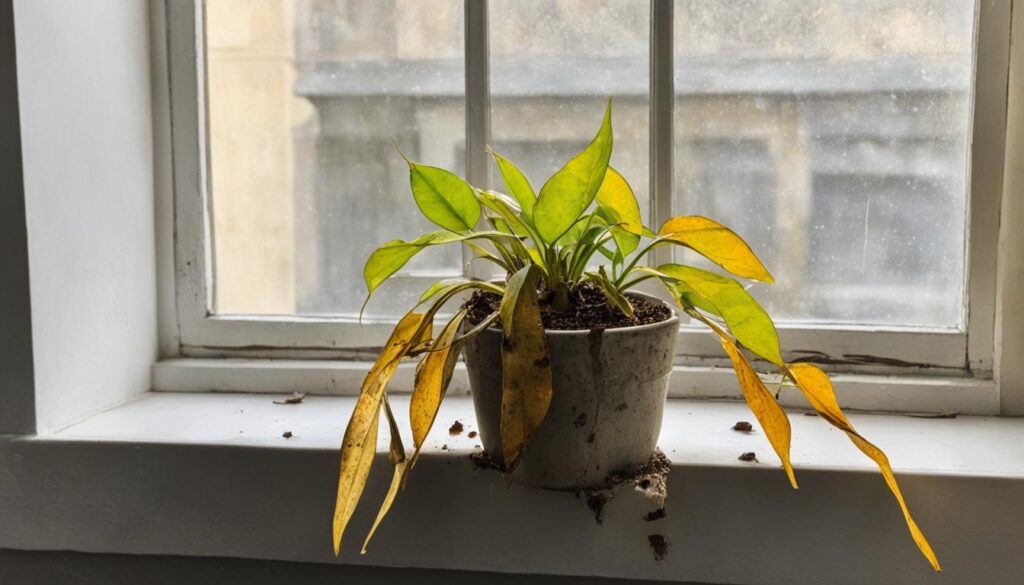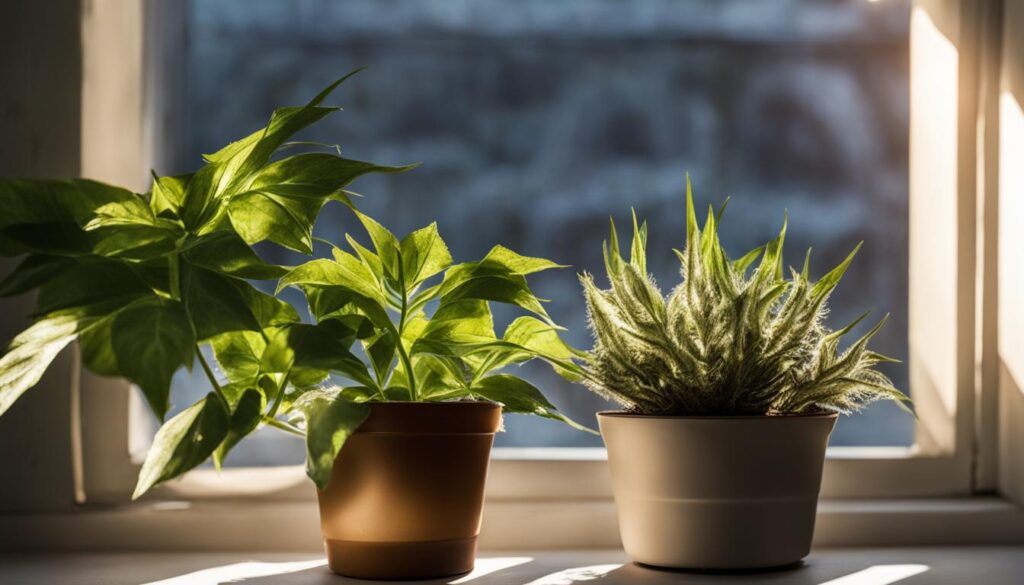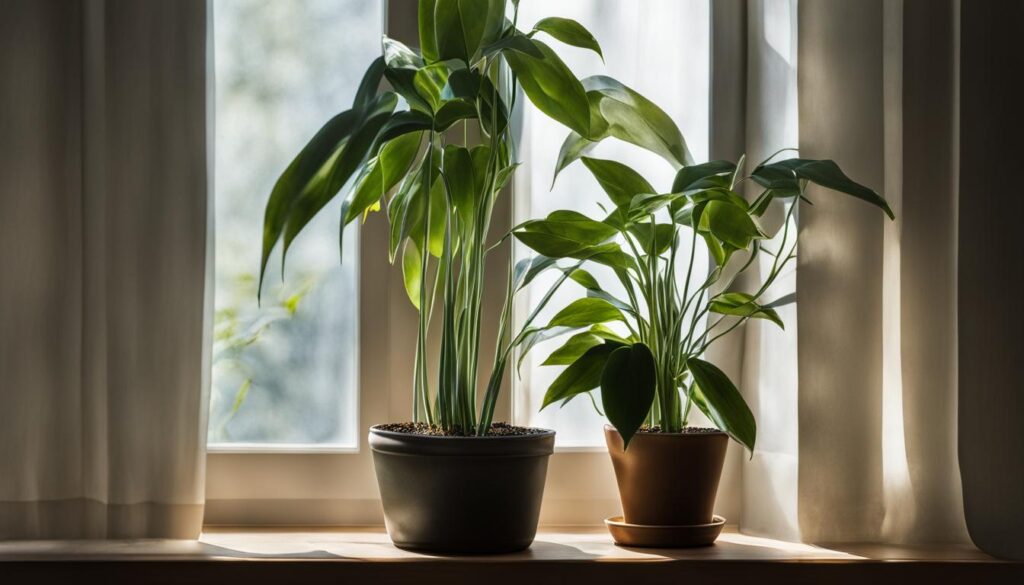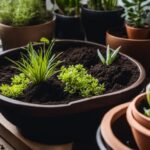Common houseplant problems or indoor plants Troubleshooting and how to fix them, Treatment, Prevention and Care Tips
Despite my best efforts to maintain a little greenery around the house, foliage, and florals can have a way of wilting, drooping, and drying out with seemingly little explanation. But before I totally renounce my green thumb, I try to get to the bottom of my houseplant troubles with some simple troubleshooting. To help you out, I’ve rounded up a few of the most common problems when it comes to keeping houseplants healthy and thriving, including everything from how to spot each issue to how to fix it.

Common Houseplant Problems and Treatment, Prevention and Care Tips
Root Rot: Identifying and Treating the Problem
When it comes to houseplant care, maintaining healthy roots is crucial. If you notice your houseplants appearing wilted, worn, or discolored, root rot could be the culprit. Root rot occurs when a plant’s roots begin to decay due to insufficient drainage.
To identify root rot, carefully examine the roots of your plant. Mushy and fragile roots are a telltale sign of the issue. If left untreated, root rot can lead to the eventual death of the plant.
To fix root rot and revive your wilting houseplants, follow these steps:
- Gently rinse off the affected roots under running water to remove any excess moisture and decayed matter.
- Trim away the mushy and damaged roots using clean, sharp scissors or pruning shears.
- Once the roots are cleaned and trimmed, repot the plant in fresh, well-draining soil.
- Choose a container with plenty of drainage holes to prevent water from pooling around the roots.
- After repotting, ensure you adjust your watering routine to avoid overwatering and create optimal conditions for root health.
By addressing root rot and providing proper drainage, you can help your houseplants recover and thrive once again.
Preventing Root Rot
Prevention is key when it comes to root rot. To avoid this issue in the future, here are some houseplant care tips to promote healthy root systems:
- Use well-draining soil specifically formulated for houseplants.
- Ensure your plant’s pot has sufficient drainage holes.
- Avoid overwatering by allowing the top few inches of soil to dry out before watering again.
- Remove any excess water that accumulates in the pot’s saucer or tray.
- Regularly inspect your plant’s roots for signs of rot or decay.
Remember, healthy roots are the foundation for healthy houseplants. Taking the time to address and prevent root rot will help your plants thrive and bring beauty to your indoor space.
Overwatering: Signs and Solutions
While it’s important to stay on top of watering your houseplants, overwatering is a common problem that can lead to wilting and brown spots on plant leaves. To avoid overwatering, familiarize yourself with the general water requirements for your plant variety. One quick way to check if your plant needs watering is to stick your finger one inch into the soil. If it feels dry, it could probably use some water. When the top looks dry but the soil below is moist, hold back on watering.
Signs of Overwatering:
- Wilting, yellowing, or drooping leaves
- Moldy or foul-smelling soil
- Root rot, characterized by mushy and fragile roots
How to Fix Overwatered Houseplants:
- Assess the soil: If the soil feels consistently wet or waterlogged, gently remove the plant from its pot to examine the roots.
- Trim-affected roots: If you notice mushy or blackened roots, carefully trim them away using clean shears or scissors.
- Repotting: Choose a pot with proper drainage holes and fresh, well-draining soil mix. Repot the plant, making sure not to bury the stem too deeply.
- Adjust watering frequency: Allow the plant’s soil to dry slightly between waterings. Adjust the watering schedule based on the specific needs of your plant.
By being mindful of your houseplant’s water requirements and avoiding overwatering, you can help prevent wilting, root rot, and other associated problems. Remember, it’s better to slightly underwater than to overwater your plants. Regularly monitor your plants and provide them with a balanced water routine to maintain their health and vitality.
Insufficient Light: How to Boost Sun Exposure
Sunlight is essential for the health and growth of houseplants. Insufficient light can lead to yellow leaves and stunted growth. To prevent these issues and ensure your plants thrive, it’s important to provide them with adequate sun exposure. If your houseplants are becoming leggy and sending out spindly, weak stems, it’s a clear indication that they are not receiving enough light.
To address this problem, you can:
- Move the plant closer to a window that receives more light.
- Switch the plant to a window that provides brighter light.
- Rotate your plants regularly so that all sides receive equal access to sunlight.
- Invest in a grow light if finding a suitable spot for the plant is difficult.
Tip: When moving your plants closer to a window, be cautious about placing them next to cold wintry windows. Temperature fluctuations can affect plant health, so it’s important to strike a balance between adequate light and stable temperatures.
By optimizing the amount of light your houseplants receive, you can prevent yellow leaves and promote healthy growth. Remember, every plant has different light requirements, so it’s essential to understand the needs of your specific plants and provide them with the right amount of sunlight.
Nutrient Deficiency: Remedying Lacking Nutrients
When it comes to caring for your houseplants, nutrient deficiency is a common issue that can lead to unhealthy-looking plants and yellowing leaves. Discolored leaves are often an indication of a lack of essential nutrients such as nitrogen, phosphorous, and potassium.
To address nutrient deficiencies and keep your plants vibrant and thriving, there are a few steps you can take. Adding nutrient-rich fertilizer to the soil is an effective way to provide the necessary elements your plants may be lacking. Choose a fertilizer specifically formulated for houseplants and follow the recommended dosage instructions.
Pro Tip: Organic solutions can also be used to boost the nutrient content of your plants. Coffee grounds, for example, are a natural source of nitrogen and can be sprinkled on the soil to enhance nutrient levels.
In addition to fertilizing, it’s important to make sure your plants are receiving adequate water and sunlight. Healthy roots are better able to absorb essential nutrients from the soil, so maintaining proper watering and light conditions is crucial for overall plant health.
Examples of Nutrient-Rich Fertilizers:
| Fertilizer | Key Nutrients | Application |
|---|---|---|
| Jack’s Classic All-Purpose Fertilizer | Nitrogen, Phosphorous, Potassium | Mix the recommended amount with water and water your plants as usual. |
| Miracle-Gro Water Soluble All Purpose Plant Food | Nitrogen, Phosphorous, Potassium | Dissolve the recommended amount in water and use it to water your plants every 1-2 weeks. |
| Jobe’s Organics All Purpose Fertilizer Spikes | Nitrogen, Phosphorous, Potassium | Push the spikes into the soil near the plants’ roots according to the package instructions. |
“Proper nutrition is essential for healthy plant growth and development. By addressing nutrient deficiencies, you can ensure that your houseplants thrive and continue to bring beauty to your home.”
Low Humidity: Providing Moisture for Houseplants
Houseplants prefer moist, slightly humid environments, which is not usually the condition of indoor air. If your plant’s leaves are browning and drying, it may be craving more moisture. Ensure the plant is not placed near heat sources and offer occasional misting of water. Placing a tray with pebbles and water under the potted houseplant can also increase humidity.
To create a more hospitable environment for your houseplants, it’s important to understand that low humidity can be detrimental to their health. Without adequate moisture, plants can suffer from dryness, wilting, and the development of brown, crispy leaves.
To combat low humidity levels, try these houseplant care tips:
- Keep your plant away from direct heat sources like radiators, heaters, and air vents. These can quickly dry out the air, leading to low humidity conditions.
- Provide occasional misting or spraying to increase the moisture around your plant. Make sure to use room temperature water and gently mist the leaves, avoiding excessive water on the soil.
- Place a tray filled with pebbles and water beneath your potted plant. As the water evaporates, it creates humidity around the plant.
“Low humidity levels can cause houseplants to suffer from dehydration, resulting in dry and unhealthy foliage. Creating a more humid environment can help revive your plants and promote healthier growth.”
By implementing these simple houseplant care tips, you can provide the necessary moisture your plants need to thrive. Remember to monitor your plants closely and adjust their care as needed. With a little extra attention, you can fix dry houseplants and enjoy their lush beauty in every corner of your home.
Temperature Fluctuations: Minimizing Plant Stress
Constant shifts in temperature can cause plants to look droopy. Fluctuating temperatures disrupt the delicate balance that plants need to thrive. As a result, they may appear wilted or limp. To prevent this, it’s important to provide a stable environment for your houseplants.
One of the simplest ways to minimize temperature fluctuations is to avoid moving potted plants between different rooms with varying temperatures. Constantly subjecting plants to changes in heat or cold can induce stress and negatively impact their health. Instead, find a suitable spot for your plants that maintains a relatively consistent temperature.
In addition, consider adjusting the thermostat at night to mimic natural conditions. Slightly lowering the temperature can help replicate the cool nighttime temperatures that many plants experience in their natural habitats. This can promote healthier growth and reduce the likelihood of your plants becoming droopy.
Remember, each plant has its own specific temperature preferences, so it’s essential to research and understand the environmental conditions that best support your particular houseplants.

Quick Tips to Minimize Temperature Fluctuations:
- Find a suitable spot for your plants that maintains a consistent temperature.
- Avoid moving potted plants between rooms with different temperatures.
- Consider slightly lowering the thermostat at night to replicate natural conditions.
Insects and Disease – Identifying and Treatment
Indoor plants can be prone to unwanted plant pests like mealybugs. These pests can cause stunted growth, yellowing leaves, and plant death. Unusual growth patterns, such as curling or distorted leaves, are often signs of insect presence or disease. When you notice black spots or fuzzy white spots on your houseplants, it is likely a disease that needs attention. Fortunately, there are effective treatments you can utilize to address these issues and restore your plant’s health. To effectively treat an infestation and ensure the well-being of your houseplants, consider the following strategies:
- Wiping leaves with rubbing alcohol: Gently wiping the affected leaves with a cotton ball soaked in rubbing alcohol can help eliminate mealybugs and their eggs. Pay special attention to the undersides of leaves, as mealybugs tend to hide there. This method is especially effective for small infestations.
- Using neem oil spray: Neem oil, derived from the neem tree, is a natural insecticide that can effectively control mealybugs. Dilute neem oil according to the manufacturer’s instructions, then apply it to the infested areas of the plant. Repeat the treatment every 7-10 days until the infestation is resolved.
- Applying an insecticidal spray: If other methods fail to eradicate the mealybugs, consider using an insecticidal spray specifically formulated to target these pests. Follow the instructions provided with the spray carefully, ensuring that it is safe to use on your particular type of houseplant.
- Pruning: Another approach to combating disease is removing affected areas from your plant. By cutting away the damaged portions, you can prevent the disease from spreading further. It is important to use clean and sterilized tools when pruning your plants to avoid introducing additional pathogens.
List of Common Houseplant Diseases and Insects
| Disease | Common Symptoms | Treatment |
|---|---|---|
| Fungal Leaf Spot | Black spots on leaves | Apply neem oil or remove affected areas |
| Powdery Mildew | Fuzzy white spots on leaves | Apply neem oil or remove affected areas |
| Aphids | Small, soft-bodied insects clustered on leaves | Crush with fingers or use neem oil |
| Spider Mites | Visible webs and stippling on leaves | Crush with fingers or use neem oil |
| Scale Insects | Tiny, immobile insects on stems and leaves | Crush with fingers or use neem oil |
DIY sprays made from garlic, onion, and cayenne pepper can also be effective in controlling mealybugs. These natural deterrents create an inhospitable environment for the pests and help prevent further infestations. However, it’s important to test these homemade sprays on a small section of the plant before applying them more broadly to ensure they don’t cause any adverse effects.
Remember to closely monitor your plants for any signs of recurring infestations and take swift action to address them. With consistent care and proactive pest control measures, you can keep your houseplants healthy and free from destructive pest infestations.
Brown Leaf Tips – Inconsistent Watering and Excess Salt
If you’ve noticed brown tips on the leaves of your houseplants, it’s likely due to inconsistent watering or excess salt. To keep your plants healthy and vibrant, it’s important to address these issues. Here’s how:
Inconsistent Watering
Inconsistent watering can lead to brown leaf tips. It’s essential to water your plants when they need it and ensure that the water reaches the entire root system. Avoid overwatering or allowing the plant to sit in water, as it can cause root rot. Here are some tips:
- Check the moisture level of the soil before watering. Stick your finger about an inch deep into the soil, and if it feels dry, it’s time to water.
- Water thoroughly until the water starts to drain from the bottom of the pot.
- Ensure proper drainage by using pots with drainage holes and appropriate potting soil.
- Consider using a moisture meter or self-watering pots to help maintain consistent watering.
Excess Salt
Excess salt can also cause brown leaf tips. Over time, the salts found in tap water and fertilizers can build up in the soil and affect the plant’s health. Here’s what you can do:
- Use distilled water instead of treated tap water. Distilled water contains fewer salts and minerals, reducing the risk of salt build-up.
- Flush the soil with water periodically to remove excess salts. Water the plant until the water drains clear from the bottom of the pot.
- Consider repotting the plant with fresh potting mix to replace the salt-laden soil.
By addressing inconsistent watering and excess salt, you can help prevent brown leaf tips and ensure your houseplants thrive. Take a proactive approach to care for your plants, and they’ll reward you with lush, healthy foliage.
| Problem | Cause | Solution |
|---|---|---|
| Brown Leaf Tips | Inconsistent watering | Water plants when needed, ensuring thorough watering and proper drainage. Use distilled water to prevent salt build-up. |
| Excess salt | Flush soil with water and repot with fresh potting mix to remove excess salts. |
Yellowing Leaves – Underwatering, Overwatering, or Low Light
If you notice yellow leaves on your houseplants, it’s important to address the issue promptly. Yellowing leaves can be a sign of various problems, including underwatering, overwatering, or low light conditions. To ensure the health and vitality of your plants, here are some essential tips:
- Proper watering: Water your plants when the top 1/2 to 1 inch of soil feels dry. Avoid both underwatering and overwatering, as these can cause yellowing of the leaves. Most houseplants should not sit in water, as it can lead to root rot.
- Adequate light: Ensure that your plants are placed in a location with sufficient light. Lack of light can weaken the plants and result in yellow leaves. If needed, consider moving them to a brighter spot or providing additional light sources such as grow lights.
- Remove yellow leaves: If you notice only one or two yellow leaves, simply pluck them off. However, if there is a significant number of yellow leaves, it may indicate a more serious issue that requires attention.
By following these guidelines, you can prevent and address yellowing leaves, promoting the overall health and beauty of your houseplants.
| Problem | Cause | Solution |
|---|---|---|
| Yellow leaves | Underwatering, Overwatering, or Low Light | – Water when soil is dry – Avoid overwatering and underwatering – Provide adequate light – Remove excessive yellow leaves |
Leaf Drop – Change in Location or Low Light
If your houseplant is experiencing leaf drop, it could be attributed to either a recent change in location or inadequate light conditions. Some houseplants, like ficus, are particularly sensitive to changes in their environment. However, if the new location provides suitable growing conditions, the plant should adjust and grow new leaves over time.
If you haven’t made any recent changes in the plant’s location, leaf drop may be signaling that the plant is not receiving enough light. Low light levels can cause stress to houseplants and result in leaf drop. To address this issue, consider two possible solutions:
- Move the plant to a brighter spot: Find a location in your home that receives more natural light, such as a south-facing window. Ensure that the plant is not placed directly in the path of intense sunlight, as it can lead to sunburn.
- Provide additional light sources: If it’s not possible to move the plant to a brighter spot, you can supplement its lighting needs by using grow lights. These artificial lights mimic the spectrum of natural sunlight and can support healthy growth.
By addressing the issue of leaf drop through location changes or improved lighting, you can help your houseplant thrive and prevent further leaf loss.
| Houseplant Problem | Causes | Solutions |
|---|---|---|
| Leaf Drop | Change in location Low light levels | – Move the plant to a brighter spot – Provide additional light sources such as grow lights |
Sunburn and Wilt – Too Much Light and Inadequate Care
Just like humans, plants can experience sunburn, leading to pale or white leaves. If your houseplant’s leaves are showing signs of sunburn, it’s crucial to take action. To address this issue, move the plant away from direct sunlight or relocate it to a window with less intense light. This will help prevent further damage and allow the plant to recover.
Leaf scorch can also occur due to fertilizer burn. If you suspect this is the cause, consider using less fertilizer or switch to distilled water when watering your plants. This will help minimize the risk of leaf scorch and maintain the overall health of your houseplant.
Wilting is another common problem that can stem from various factors, such as underwatering, overwatering, poor drainage, heat stress, disease, or low humidity. Diagnosing the exact cause of wilting can be challenging, but there are steps you can take to address it. Check the soil moisture regularly and adjust your watering habits accordingly. Ensure that the plant has proper drainage to prevent waterlogging. If necessary, repot the plant using high-quality soil. Additionally, consider lowering the temperature in the plant’s environment, as heat stress can contribute to wilting. Increasing humidity, either by misting the leaves or using a humidifier, can also help combat wilting caused by low humidity.
Moldy Soil: Fixing Soil-Related Issues
Dealing with moldy soil is a common challenge in houseplant care. Mold growth can hinder your plant’s nutrient absorption and hinder its overall growth. Luckily, there are a few simple steps you can take to fix this problem and ensure your plant’s health and vitality.
Identifying Mold Growth
Mold on or in your plant’s soil can appear as fuzzy patches or black spots. It thrives in moist conditions and can result from overwatering or poor soil drainage. If you notice any mold growth, it’s essential to take immediate action to prevent further damage to your plant.
Removing Mold from the Soil
To remove mold from the soil, you’ll need to scrape away the affected areas carefully. Start by using a small spoon or a tool like a toothbrush to gently remove the mold patches. Be cautious not to disturb the plant’s roots during this process.
Replacing the Soil
After removing the moldy soil, it’s essential to replace it with fresh, healthy soil. Choose a high-quality potting mix that is well-draining and suitable for your specific plant’s needs. Carefully repot your houseplant, ensuring that the roots are covered with the fresh soil.
Improving Soil Drainage and Air Circulation
Mold growth often occurs in soil that is consistently wet or lacks proper drainage. To prevent future mold problems, consider enhancing the soil’s drainage by adding perlite or coarse sand. These amendments help create air pockets and improve water flow. Additionally, ensure that your plant has adequate air circulation by placing it in a well-ventilated area.
Exposing the Soil to Sunlight
Mold thrives in dark, damp environments. Exposing your plant’s soil to sunlight can help inhibit mold growth. If possible, place your houseplant in a location where it can receive indirect sunlight for a few hours each day. The sunlight will help dry out the soil and deter mold from reoccurring.
Incorporating these measures into your houseplant care routine can effectively address moldy soil issues and create a healthier growing environment for your plants.
Leggy or Sparse Growth: Providing Adequate Light
Leggy or sparse growth in your houseplants is a clear indicator that they are not receiving enough light. Without adequate light, plants struggle to produce sturdy stems and dense foliage, resulting in a stretched and spindly appearance. To address this issue and help your plants thrive, here are some houseplant care tips for fixing sparse growth:
1. Find a spot with brighter light: Identify a location in your home that receives more direct sunlight or has brighter ambient light. This could be near a south-facing window or under a grow light specifically designed for indoor plants. Giving your plants access to more light will encourage compact growth and lush foliage.
2. Increase exposure to light: If your plants are not getting enough natural light, you can supplement it by increasing their exposure to artificial light. Consider extending the duration of time your plants are exposed to light, or if using grow lights, adjust the height and intensity to optimize their impact.
3. Rotate your plants: Uneven light distribution can contribute to leggy growth. Rotate your plants periodically, ideally every few weeks, so that different sides of the plant receive equal exposure to light. This will help promote balanced growth and prevent plants from leaning towards the light source.

By providing your houseplants with adequate light, you can help them overcome leggy or sparse growth and promote healthier, more compact foliage. Remember to assess your plants’ light requirements and adjust their positioning accordingly to ensure optimal growth and development.
FAQ
How can I identify and treat root rot in my houseplants?
Look for mushy and fragile roots, and if found, gently rinse off the roots and trim away the affected ones. Repot the plant in fresh soil and a container with good drainage.
How can I prevent overwatering my houseplants?
Check the soil moisture by sticking your finger one inch into the soil. Water only when it feels dry. Avoid watering when the top looks dry but the soil below is moist.
What should I do if my houseplant is not getting enough light?
Move the plant closer to a window for increased sun exposure. Avoid placing plants next to cold wintry windows as temperature fluctuations can also affect plant health.
How do I address nutrient deficiencies in my houseplants?
Add nutrient-rich fertilizer to the soil or use organic solutions like coffee grounds to boost nutrient content.
What can I do to increase humidity for my houseplants?
Avoid placing the plant near heat sources, mist the leaves occasionally, or place a tray with water and pebbles under the pot to increase humidity.
How can I prevent temperature fluctuations from affecting my houseplants?
Avoid moving potted plants between different rooms with varying temperatures. Consider slightly lowering the thermostat at night to mimic natural conditions.
How do I treat mealybug infestations in my houseplants?
Wipe leaves with rubbing alcohol, use neem oil spray, apply insecticidal spray, or use DIY sprays made from garlic, onion, and cayenne pepper.
What should I do if there is mold on or in my plant’s soil?
Remove mold from the soil by scraping it away and replacing the soil if necessary. Improve soil drainage, air circulation, and expose the soil to sunlight to prevent mold growth.
How can I encourage better growth in leggy or sparse houseplants?
Move the plant to a spot with brighter light or increase exposure to light during the day. Rotate your plants to ensure equal light distribution.
How can I maintain healthy indoor plants?
Identify the specific problem your plant is facing and take appropriate measures to fix it. Maintain a regular watering schedule, provide adequate sunlight, and monitor humidity levels. Learn about your individual plants’ needs and adjust your care accordingly.
What are some common houseplant problems?
Some common houseplant problems include leggy growth, curling or distorted leaves, brown leaf tips, yellowing leaves, leaf drop, sunburned leaves, and wilting.
How can I address leggy growth and weak stems in my houseplants?
To address leggy growth, move the plant closer to a window or switch it to a window that receives more light. Rotating your plants can also ensure equal access to sunlight. If finding a suitable spot is difficult, investing in a grow light can provide the necessary light for healthy growth.
What should I do if my houseplants have curling or distorted leaves?
Curling or distorted leaves are often signs of insect presence or disease. Treat the plant with neem oil or by removing affected areas if it’s a disease. For insects, you can crush them with your fingers or use neem oil. Providing adequate air circulation and promptly removing dead foliage can help prevent disease and insect infestations.
How can I prevent and treat brown leaf tips in my houseplants?
Brown tips on leaves can be caused by inconsistent watering or excess salt. Water the plants only when needed and ensure that the water reaches the entire root system. Avoid overwatering or allowing the plant to sit in water to prevent root rot. If excess salt is the issue, flush the soil with water until it drains clear or repot the plant with fresh potting mix. Using distilled water instead of treated tap water can also help prevent salt build-up.
What can I do about yellow leaves on my houseplants?
Yellow leaves can indicate underwatering, overwatering, or low light conditions. Water the plants when the soil feels dry about 1/2 to 1 inch down, avoiding both underwatering and overwatering. Ensure that the plants are placed in a location with adequate light. If there are only one or two yellow leaves, you can simply pluck them off. However, if there are a significant number of yellow leaves, it may indicate a more serious issue that requires attention.
Why are my houseplants dropping leaves?
If your houseplant is dropping leaves, it could be due to a recent change in location or low light conditions. Some plants are sensitive to changes in their environment. If the new location still provides suitable growing conditions, the plant should grow new leaves after adjusting. If you haven’t changed the location recently, leaf drop may indicate low light levels. Consider moving the plant to a brighter spot or providing additional light sources.
How can I address sunburned leaves and wilt in my houseplants?
To address sunburned leaves, move the plant away from direct sunlight or to a window with less intense light. Leaf scorch can also be caused by fertilizer burn, so using less fertilizer or switching to distilled water can help. Wilting can be caused by various factors such as underwatering, overwatering, poor drainage, heat stress, disease, or low humidity. Check the soil moisture and adjust watering habits, improve drainage, lower the temperature, repot with better soil, or increase humidity through misting to address wilting issues.




